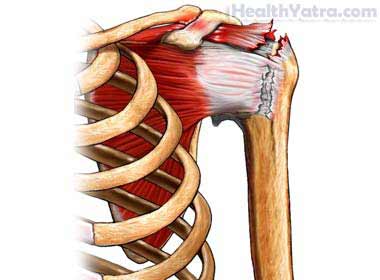Definition
The rotator cuff is a group of four muscles in the shoulder and upper arm. The muscles help to move the arm at the shoulder and also help to stabilize the joint. The muscles are connected to the shoulder bone by tendons, which are strong, flexible cords. Tendons may become damaged from long term overuse or from injury.

Reasons for Procedure
Your doctor may recommend this procedure for:
- A rotator cuff injury which does not respond to rest and physical therapy treatment
- A complete tear in the tendon
- Chronic pain and weakness from a partial tear in the tendon
Possible Complications
Problems from the procedure are rare, but all procedures have some risk. Your doctor will review potential problems, like:
- Infection
- Excess bleeding
- Blood clots
- Reaction to anesthesia
- Weakness or numbness in shoulder joint
- Detachment of the shoulder muscle
- The operation does not provide the desired improvement in function
Smoking may increase the risk of complications and slow healing.
What to Expect
Prior to Procedure
Your doctor may do the following:
- Physical exam
- Blood tests
- Shoulder x-ray
- MRI to see the internal structure of the shoulder
Before this procedure, you will need to:
- Arrange for help at home while you recover
- Talk to your doctor about any medications, herbs, or supplements you are taking
- Talk to your doctor about any allergies you have
- Ask your doctor about assisted devices you will need
You may need to stop taking some medications up to one week before the procedure. Medications that may need to be stopped may include:
- Aspirin or other anti-inflammatory drugs, such as ibuprofen or naproxen
- Blood-thinning drugs, such as warfarin
- Anti-platelet drugs, such as clopidogrel
Do not eat or drink anything after midnight the day before your procedure, unless told otherwise by your doctor.
Anesthesia
General anesthesia is typically used. You will be asleep during the procedure.
Description of Procedure
There are two methods used to perform a rotator cuff repair:
Open Surgery
The doctor will make a cut in the skin over the shoulder. The torn tendon will be repaired and reattached and/or anchored with stitches. The incision will then be closed with stitches or staples.
Arthroscopic Surgery
A few small incisions will be made in the shoulder. A narrow tool called an arthroscope will be inserted through the incision. The scope has a tiny camera to allow the doctor to see inside. Other small instruments will be inserted through the other incisions. The doctor will use these tools to repair the tendon.
After either procedure, the incisions will be bandaged. Your arm will be placed in a sling or brace to immobilize the joint.
How Long Will It Take?
About 1-½ to 2 hours
How Much Will It Hurt?
Anesthesia prevents pain during the procedure. You may have some discomfort immediately after. Ask your doctor about medication to help with the pain.
Average Hospital Stay
You may be able to go home the same day. Some may need to stay in the hospital for one day.
Post-procedure Care
At the Care Center
Right after the procedure, you may be given medication, such as:
- Pain medication
- Antibiotics to prevent infection
- Medication that prevents blood clots
At Home
When you return home, take these steps:
- Use ice to reduce swelling after the surgery.
- Take the full doses of all medications prescribed.
- Keep the bandage clean and dry at all times.
- Ask your doctor about when it is safe to shower, bathe, or soak in water.
- Do not use the arm until instructed. Wear the sling or brace as directed.
- Unless your job requires heavy lifting, you can usually return to work within a few days after the surgery.
- Follow instructions for physical therapy. Therapy is essential to regain shoulder strength and range of motion.
- Be sure to follow your doctor’s instructions.
The rotator cuff will take several months to heal. It may take some time before you can raise your arm above your shoulder. It may be up to one year before you can hold your arm above your head and do work with reasonable strength. An aggressive and consistent exercise program is the key to a faster recovery.
Call Your Doctor
After arriving home, contact your doctor if any of the following occurs:
- Signs of infection, including fever and chills
- Redness, swelling, increasing pain, excessive bleeding, or discharge at the incision site
- Pain cannot be controlled with medications given
- Nausea or vomiting
- Cough, shortness of breath, or chest pain
- The stitches or staples come apart
If you think you have an emergency, call for medical help right away.
